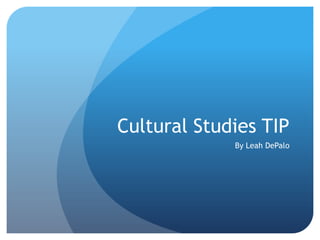
Cultural studies
- 1. Cultural Studies TIP By Leah DePalo
- 2. Audience Decoding Decoding: the receiving and comparing of messages based off one’s own perceptions, thoughts, and past experiences. An instantaneous reaction that yields an immediate decision about how a message is interpreted. Bud and Steinmen (1992) note that subordinate cultures decode messages of the ruling class.
- 3. Three Positions of Decoding Dominant-hegemonic Negotiated Oppositional
- 4. Dominant-Hegemonic Position When individuals operate within a code that allows one person to exercise control over another. Professional codes reproduce hegemonic interpretations of reality by utilizing subtle persuasion. Word selection, picture presentation, and the choice of spokespeople are part of staging the professional code. Ex. The professional code of television broadcasters, or spokespeople for infomercials. To prevent the audience from misunderstanding presented messages, television producers (the media) strategically places the professional code in the larger, dominant cultural code.
- 5. Negotiated Position When audience members are able to accept dominant ideologies, but will operate with some exceptions to the cultural rule. Audience members always reserve the right to apply local conditions to large-scale events. Example: Accepting the elite’s interpretation of a reform bill in Washington, D.C, but on the local front opposing it due to conflicting personal beliefs or local principles.
- 6. Oppositional Position When audience members substitute an alternative code for the code supplied by the media. Intended media codes are rejected and are replaced with consumers personal views of the subject. Example: Feminine images of “beauty”, as communicated by the media.
- 7. Integration Communication Tradition: Critical This theory is concerned with oppression, power, and dominance and also critiques the social order and imposing structures on individuals, which classifies Hall’s theory as critical Communication Context: Mass/Media This theory is communicated to a very large audience through means of media itself. Approach to Knowing: Interpretive/Hermeneutic, Critical Interpretive/Hermeneutic: This theory takes an interpretive approach because the “truths” as portrayed through the media are subjective to the beliefs of the audience. Critical: This theory takes a critical approach because it explains how those in power shape knowledge as portrayed through media to perpetuate the status quo in society.
- 8. Integration Generality: Mid-range This theory is mid-range due to the fact that it does not apply in a universal manner. Although it can be argued that roles of power and hierarchal structures can be found in many cultures, it must be considered that the media does not influence all cultures in the same amount. For example, countries such as the United States, and Great Britain who are more advanced in technology and media will be more affected by media influence as compared to a country who is not as technologically advanced.
- 9. Goal The goal of this theory is to explain how the media plays a substantial role in the development and progression of varying cultures. The goal of this theory is also to make general audiences aware that they may unknowingly become subjected to the messages of the “elite”, who determine the importance of media.
- 10. Critique Scope: Wide; this is because there is a wide audience of people that have access to means of media (i.e television, internet, magazines), and therefore have a greater chance of being subjected to the messages presented. Logical Consistency: Questioned; this is due to the fact that the criticism relates to the audience, and the media may have different impacts on some people as compared to others. Parsimony: Simple concept, but the theory is a subject of variations, due to the fact that the influence of media can have different effects on varying cultures and groups of people. Utility: Highly useful; the theory can be seen in everyday life; the theory also acts to support the cultural struggles of the underprivileged in society- helped to formulate subfields of marginalized social groups.
- 11. Critique Testability: Can be proven false under circumstances concerning the different effects media messages have on the views of the audience. Heurism: Highly heuristic; the ideology of the theory has been examined and the concept of hegemony in media has been applied in pop culture, and has also been written about in various novels. Test of Time: Not yet determined; the theory was formulated in the 1980s, when different forms of media were becoming more widespread; it can be predicted however that the usage of media will only increase over time as technological advances increase.
- 12. Personal Account Over the summer, after me and my friends volunteered at the local animal shelter near my house, I sat down to watched T.V and was intrigued by one of the ASPCA commercials seeking charitable donations. Due to my previous experience earlier that day, the short program with its melancholic music and disturbing images appealed to my sympathetic side. After viewing, I promptly joined the yearly plan for donations after being moved in such a way to help a good cause. This example demonstrates the cultural studies theory and the influence of media in our culture due to the fact that the media exposes us to things we may not otherwise see on a day to day basis. In this case, a skewed dominant-hegemonic position was taken, due to the fact that the disturbing images and sad music were used as devices to help persuade skeptical people to donate to the charity presented.
- 13. Discussion Question What time of media do you believe is most pervasive and had the most influencing power in shaping the culture in the United States? (for example, television and film, music, internet, printed news and magazines, etc)